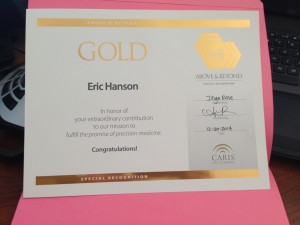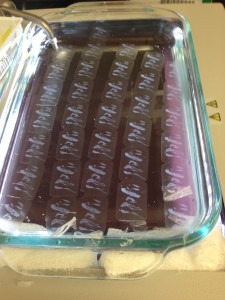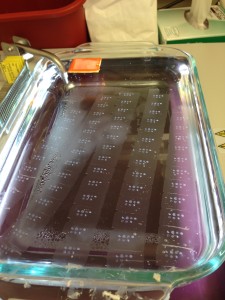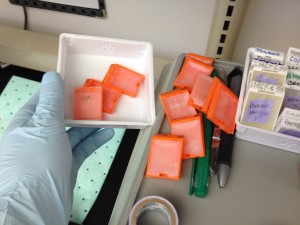
Most commonly used microtome at Caris Lifesciences. I’ve cut many specimens using this instrument.
This is easily the most complicated process performed in the immunohistochemistry (IHC) lab at Caris Lifesciences. All of the quality control that is done in the lab is dependent on the TMA. So without these cutting and staining well, the lab comes to a standstill and repeats have to be performed on a large number of tests. This delays production and costs enormous amounts of money. The TMA production was my primary responsibility at Caris. I also developed a method to save the company between 100-350k on bulk tissue costs by implementing a shallower tissue punch in the block.

I can’t go into too fine of detail on the process, but I’m quite familiar with how these are made. I’ve written the complete standard operating procedure (SOP) on this process, and many other processes, for Caris Lifesciences.
The outline of the process for making TMAs is as follows: bulk tissue purchasing, bulk tissue cutting, quality analysis/positive staining, block marking, TMA blank block production, tissue punching, and lastly, quality control.
Bulk Tissue Purchasing
It’s incredibly hard to find a reliable source(s) for tissue and the distribution/purchasing of such tissue is sort of in a legally gray area. The tissue we receive must stain positive, dependent upon tissue type, for the immunohistochemical (IHC) stains we are performing on patient tissue. So this means we need human tissue that has tumor in it. Thankfully the process we have implemented uses the least amount of tissue as possible to maximize the usability of the bulk tissue blocks.

Bulk Tissue Cutting
After the bulk tissue blocks are received, each has to be sorted into tissue types and then the tissue types that are going to be punched in to the TMA have to be cut on the microtome. One section for each stain it is suppose to stain positive for must be cut. For some of the tissue types such as HER2 positive breast tissue, only needed one slide cut, but for others, as many as 11 slides per block had to be cut.
Bulk Tissue Quality Analysis
Each block has to stain positive for each of the stains it is going to be used as a positive control on. So for each block, the IHC slides must be looked at closely to make sure uniform staining has occurred and it is staining the right sections of tissue. These IHC tests usually stain a certain tissue type the best such as epethilial, nerve, capillary wall, mucousal, etc cells. During the tissue validation phase, all the different tissue types are stained with all of our stains and then a pathologist looks at them to determine which ones they want for positive controls.

As part of the quality analysis of the tissue, once determined that that tissue block is suitable for use in the TMA, the stained slides are then each marked to highlight the area we are interested in punching. These punches go into the blank TMA blocks to make the cutable TMA.
Block Marking
After we’ve determined that the block has stained positive for all of the tests it needs to, the positive portions are marked on the coverslip of the glass slide. These marked slides are then overlaid on the block and used to mark the tissue in the block with a statmark pen.
TMA Blank Block Production
Now that there are a lot of blocks marked of each tissue type that is going to go into the TMA, we need to make TMA blank blocks to put the punched tissue into. Depending on the size of the punches and the number of punches for the TMA, a mold size is chosen. Plastic cassettes, generally of a different color than the patient specimen color, are printed out and placed on top of each mold. Paraffin is poured in the mold and then the perfect amount of paraffin needs to remain in the back of the plastic cassette. Without the paraffin backing the cassette, it’s really easy for the portion in the mold to fall off when cutting the cassette or punching through the plastic cassette when making the TMAs.
Tissue Punching

During this step a predefined set of coordinates is used to punch certain tissue types into certain areas of the block. To streamline the punching process, I would set the instrument to the first coordinate and recipient-punch all the blank TMA blocks at that location. Line those up, usually 10 at a time, and then use the bulk tissue blocks and donor-punch them set aside the cores on a cutting board. To prepare the cores for the blank TMA blocks, the paraffin on the bottom has to be sliced off using a scalpel. The tissue is then stacked in the hole on the donor block (blank TMA block). The whole process then repeats itself for each coordinate.
Quality Control of the Finished TMA Block
Once a block has been fully completed, through trial and error, we figured out that baking the blocks for a set amount of time helped embed the tissue cores in the paraffin a little better. Most TMA blocks have problems with the tissue cores being pulled out by the blade during microtomy.

Once they are cooled a couple sections are cut off each and they are stained H&E to look for the correct cell morphology in each core, and then put them into production. Each microtomist gets a block and uses it to cut a section on each slide that already contains patient tissue and that is also going to be stained one of the IHC stains we did at Caris.

Tissue embedding is a pretty simple task. Processed tissue is placed in a mold and paraffin is then drizzled on top of it. A plastic cassette is then placed on top of the mold and it’s set on a cold plate to cool. This creates the formalin fixed paraffin embedded (FFPE) block. These are the common standard used in all of histology. If a portion of tissue is too large for biggest mold, gross dissection of the sample is required.
This was one of my tasks when I would come into the lab on the weekend to gross the saturday samples. Sometimes we would receive samples that were already tissue processed, but received in a very large cassette, or stuffed with too much tissue for the mold they used. In this case, the FFPE block would be melted down and the tissue sectioned so it fit into one of our molds.
When performing microtomy, sometimes the tissue would pop out of the block, crack, have bad paraffin quality, or any number of things that inhibited cutting. The block would then be re-embedded using our embedding station, logged, and then sectioned with better results. This was also necessary if the tissue was on an odd plane, or one portion of the tissue was embedded further into the paraffin than the section that is hitting the microtome blade.

When I was making Tissue Micro Arrays (TMA), I would make 100 blocks at a time using this station. It was quite tedious, and getting the paraffin to properly fill the back of the plastic cassette was hard. It is necessary to get enough paraffin the back to avoid over punching the block or having the paraffin break off while performing microtomy.
At Caris Lifesciences, all of the stained slides went through a quality control process before they were able to leave the laboratory. Once out of the lab, they were looked at by a pathologist who put together a recommended treatment plan for rare and hard to treat cancers. They used a combination of immunohistochemical (IHC) stained slides, a molecular profile, and a comprehensive database of patient treatment. All of this was done in house, which helped Caris shine from the rest of the theragnostic labs.
As I progressed as a histotech, I learned more and more about looking at slides and stains to determine if things stained properly. I received training from pathologists, coworkers, and supervisors. If I had a question on a stain, I would always get the best answer I could from a supervisor. It was painstaking to learn it all, but it really helped me develop and understand and knowledge base of the stains we performed and also what a lot of tissue looks like under a microscope.

The majority of what I learned was developed when I was making tissue micro-arrays (TMA). Please see the section I’ve devoted to TMAs.
Quality control for the automated stainers (Ventana and Dako) consisted of looking at the TMA section placed on each slide. These act as positive controls for the stains. Several different tissue types were present that were know to stain positive for all of the stains. I was in charge of selecting tissue and passing the tissue by sectioning and staining each tissue type for all of the stains it was supposed to stain positive for. This was step one of the quality control process.

The final step before the slides were delivered to a pathologist was the QC stage. Someone would sit and look at the TMAs on each slide and also the tissue to make sure that it didn’t fall off and had a uniform stain. Sometimes in microtomy a section can be placed on a slide that is thick on one side and thin on the other, or had chatter or other anomalies. Once this was done, the case was logged and sent out of the lab. I spent a lot of days at the QC station. It was always a nice change of pace from the frustrating microtomy or monotonous staining procedures. It was fascinating to see all the different types of tumors and stains.
The staple of the histology lab is microtomy of formalin fixed paraffin embedded (FFPE) blocks. The microtomes and our process at Caris Lifesciences were all validated for 4μ thick sections, so all of my experience is cutting sections that thin. Frozen microtomy uses thicker sections, and some test require thicker sections to work, but we’ve found that 4μ are about one cell thickness. This allows for great visual representation of protein expression in cancer cells after our IHC staining process.
Microtomy can easily be the most frustrating thing to do in the laboratory. It only becomes so if the tissue is processed incorrectly, which a lot of the tissue I’ve sectioned has been poorly processed. There is a special window of just enough water in the tissue. Too much and it cuts poorly, and too little it just turns into powder or hardens to the point of ruining blades. Improperly decalcified bone specimens are also a bear to cut. Usually you just get what you can with those.
The process we used when doing microtomy is a bath full of heated water and ice blocks. The block goes on the ice first and then the microtome. The microtome chuck is then lined up to the face of the paraffin block and the first initial sections are cut. This is called facing the block. Depending on how that went, you would then either set the block back on the ice, or in the warm water bath.

After the initial facing of the block, you try to get a good ribbon going where each slice connects to the other due to the friction of the tissue and paraffin sliding off the blade. This ribbon is transported very careful to the warm water bath where the paraffin becomes clear. Each segment of the ribbon is teased apart using forceps, and then gently moved and picked up with a glass slide. The slides then go in a drying rack and then into ovens to bake the tissue on the slides.

Once the slides are baked, the tissue has adhered quite well to positively charged glass slides. At this point, the tissue is ready for all the testing it’s going to be enduring. Some processes require a nuclear fast red to make the tumor area pop out, and then the tumor is scraped off the slide under a dissection scope. The powder then runs through an assay to get the DNA/RNA into well plates for molecular analysis. The IHC lab I worked in ran a lot of IHC tests on each case. All of this work would be impossible without the use of microtomy.
I’m familiar with the Leica 2235 and 2255 microtomes. The first is a manual microtome, and the second is an automated one with a foot pedal. I have yet to see anyone use the automation feature on those microtomes. I don’t prefer one over the other, they both cut excellently.

